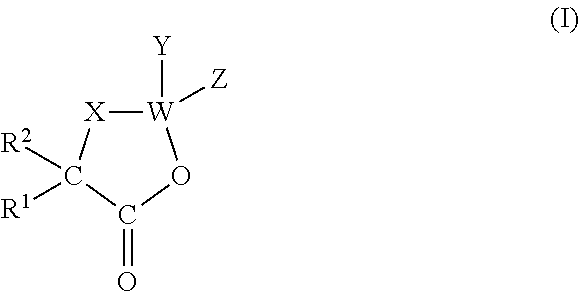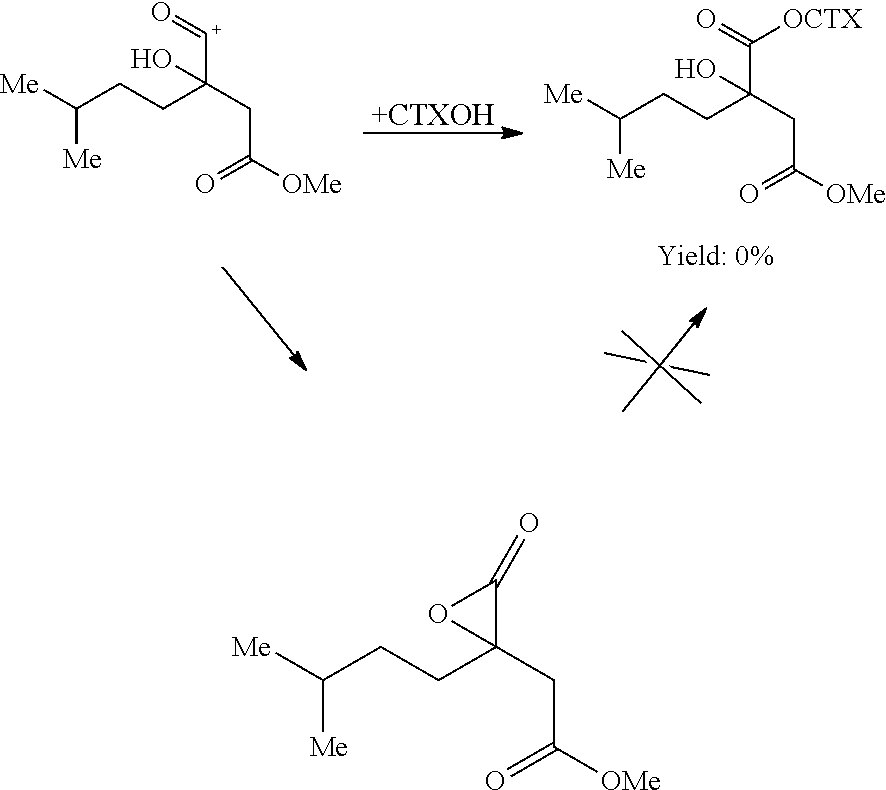Process for preparing cephalotaxine esters
a technology of cephalotaxine and esters, which is applied in the field of process for preparing cephalotaxine esters, can solve the problems of laborious synthesis of these cyclic precursors, no longer having cephalotaxine alkaloid properties, and failure to achieve laborious attempts
- Summary
- Abstract
- Description
- Claims
- Application Information
AI Technical Summary
Problems solved by technology
Method used
Image
Examples
example 1
Preparation of the Intermediate Compounds of Formula
[0103]
examples 1a
Preparation of O-, N-, S-carboxyanhydrides of General Formula
[0104]
[0105]X=O, N or S
[0106]Both of the following general procedures A and B result in the preparation of the above compounds, leading to similar yields, and the illustrated compounds below may be prepared by any one of procedures A and B. Procedure A is however more easily carried out.
General Procedure A: Disphosgene Method
[0107]1.5 equivalents of a solution of triphosgene or diphosgene in tetrahydrofuran (THF), and then 30 g per mol of pulverulent active carbon or of an amine such as pyridine or triethylamine are added dropwise, with care, to a solution or a suspension, stirred at 20° C., under an inert gas, of the alpha-hydroxy acid, of the alpha-amino acid or of alpha-mercapto acid in tetrahydrofuran (THF). The kinetics of the reaction are monitored in the following way: a 100 μL test sample is filtered through glass cotton wool and a drop is placed on the ATR accessory of a Fourier transform infrared spectrograph; th...
example 1a
[0109]
[0110]O-carboxyanhydride (“OCA”) of dimethyl glycolic acid Commercially available dimethyl glycolic-acid is treated according to the procedure above. The OCA 1a, obtained with a yield of 70-80%, has the following characteristics:
[0111]Physical state: pale yellow, thick oil
[0112]IR (ATR, film); v2971, 2859, 1892, 1870, 1808, 1780, 1259, 1168, 1064, 988, 905, 764 cm−1.
Example 1b
[0113]
[0114]O-carboxyanhydride (“OCA”) of diphenylglycolic acid Commercially available diphenylglycolic acid is treated according to the procedure above. The OCA obtained, 1b, with a yield of 70-80%, has the following characteristics:
[0115]Physical state: white crystals
[0116]1H NMR (300 MHz, CDCl3) δ 7.63-7.32 (m, 10H); 13C NMR (75 MHz, CDCl3) δ 166.90, 147.50, 134.82, 130.39, 129.43, 126.20; IR (neat) ν 3064, 1901, 1871, 1803, 1491, 1449, 1261, 1129, 1018 cm−1.
PUM
| Property | Measurement | Unit |
|---|---|---|
| temperature | aaaaa | aaaaa |
| temperature | aaaaa | aaaaa |
| temperature | aaaaa | aaaaa |
Abstract
Description
Claims
Application Information
 Login to View More
Login to View More - R&D
- Intellectual Property
- Life Sciences
- Materials
- Tech Scout
- Unparalleled Data Quality
- Higher Quality Content
- 60% Fewer Hallucinations
Browse by: Latest US Patents, China's latest patents, Technical Efficacy Thesaurus, Application Domain, Technology Topic, Popular Technical Reports.
© 2025 PatSnap. All rights reserved.Legal|Privacy policy|Modern Slavery Act Transparency Statement|Sitemap|About US| Contact US: help@patsnap.com



